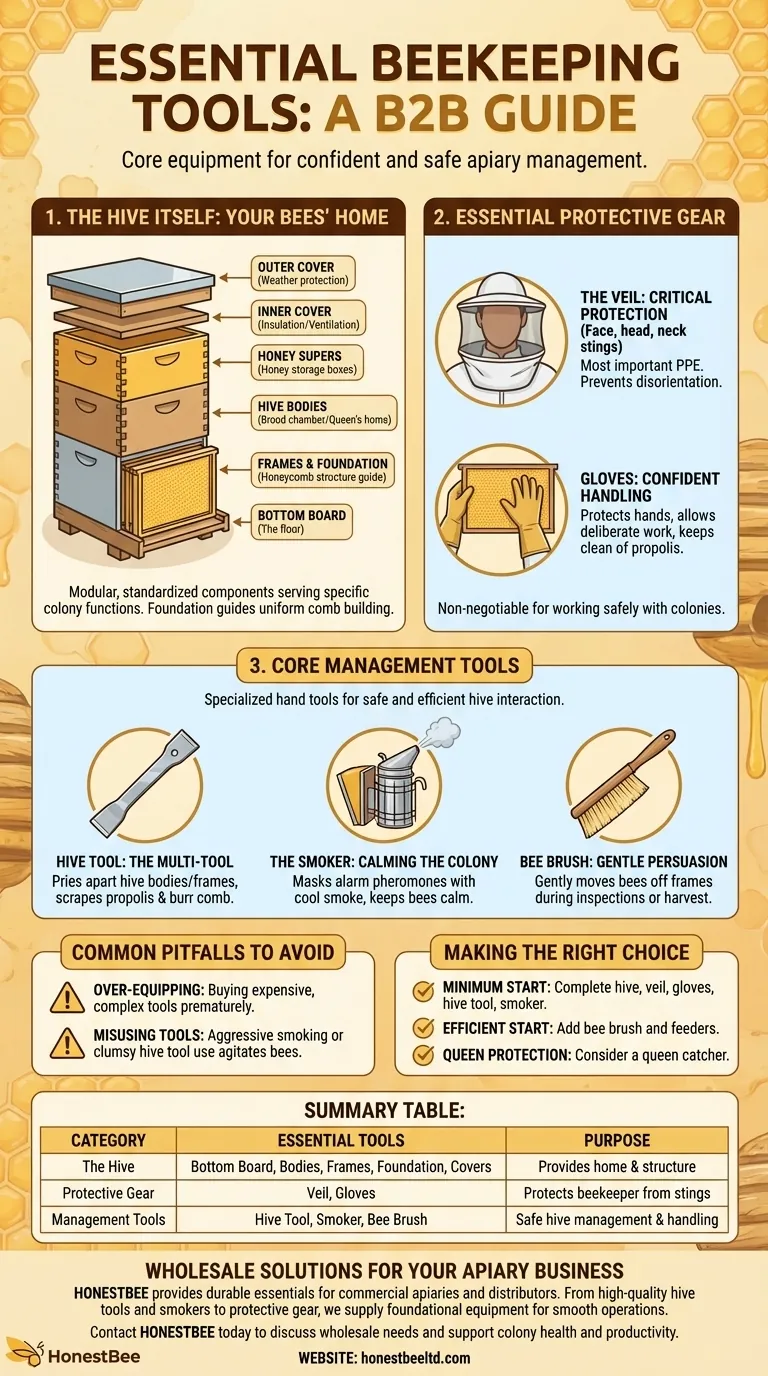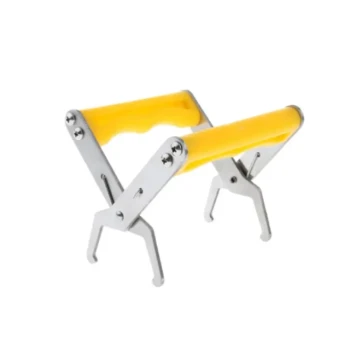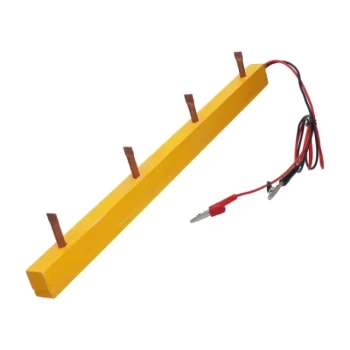To begin beekeeping, you need three categories of essential equipment: the hive itself, protective gear for yourself, and a few key tools for managing the bees. The most critical management tools are a hive tool for prying open the hive and a smoker to calm the bees during inspections.
The goal isn't to acquire every gadget, but to assemble a core kit that allows you to safely and effectively manage the colony's health, space, and productivity. Understanding the function of each basic tool is the first step to becoming a confident beekeeper.

The Hive Itself: Your Bees' Home
Before you can manage bees, they need a place to live. The modern beehive is a system of modular, standardized components that serve specific functions for the colony.
The Core Components
The hive is not a single object but a stack of boxes and parts. This includes a bottom board (the floor), one or more hive bodies where the queen lays eggs and the colony lives, frames that hang inside the bodies, honey supers for honey storage, and an inner and outer cover to protect the hive from the elements.
Foundation: A Head Start for the Colony
Most beekeepers install a sheet of beeswax or plastic called foundation into their frames. This foundation is imprinted with the hexagonal shape of honeycomb and gives the bees a guide, encouraging them to build straight and uniform comb, which makes inspections much easier.
Essential Protective Gear
Working safely and confidently with tens of thousands of stinging insects requires reliable protective gear. This equipment is non-negotiable for any beginner.
The Veil: Your Most Critical Protection
A beekeeping veil is the most important piece of personal protective equipment. It protects your face, head, and neck from stings, which are most dangerous and disorienting in this area.
Gloves: For Confident Handling
Beekeeping gloves protect your hands and allow you to work more deliberately and confidently within the hive. They prevent stings and keep your hands free of sticky propolis and honey.
The Beekeeper's Core Management Tools
During a hive inspection, you will need a few specialized hand tools to open the hive and interact with the colony safely and efficiently.
The Hive Tool: Your Beekeeping Multi-tool
The hive tool is an indispensable lever used to pry apart hive bodies and frames, which bees seal together with a sticky resin called propolis. Its scraping edge is also used to remove unwanted comb and clean hive components.
The Smoker: Calming the Colony
A smoker is a small metal canister with a bellows that burns fuel to produce cool, white smoke. Puffs of smoke mask the bees' alarm pheromones, which they release when they feel threatened. This keeps the colony calm during an inspection.
The Bee Brush: Gentle Persuasion
A bee brush has very soft bristles and is used to gently move bees off a frame. This is crucial when you need to inspect a frame for eggs or need to clear bees away before harvesting honey.
Common Pitfalls to Avoid
Understanding what not to do is as important as knowing what tools to buy. A common mistake for new beekeepers is focusing on gadgets over foundational skills.
Over-equipping vs. Under-equipping
Many beginners buy expensive kits with tools they won't use for years, such as complex queen-rearing equipment. Conversely, skimping on essentials like a quality smoker or a reliable veil can lead to frustrating and painful experiences.
Misusing the Tools
A common error is using a smoker too aggressively, which can agitate the bees instead of calming them. Likewise, using a hive tool clumsily can crush bees, releasing alarm pheromones and angering the colony. Gentle, deliberate movements are key.
Making the Right Choice for Your Goal
Your initial toolkit should be tailored to your immediate needs as a new beekeeper.
- If your primary focus is starting with the absolute minimum: You need a complete hive, a veil, gloves, a hive tool, and a smoker.
- If your primary focus is a more comfortable and efficient start: Add a bee brush for gentler bee handling and feeders to provide sugar syrup if needed.
- If your primary focus is protecting your queen during inspections: A hair clip-style queen catcher can be a useful tool for temporarily isolating and protecting the queen.
Ultimately, mastering these basic tools will empower you to manage your colonies with confidence and care.
Summary Table:
| Category | Essential Tools | Purpose |
|---|---|---|
| The Hive | Bottom Board, Hive Bodies, Frames, Foundation, Covers | Provides a home and structure for the colony. |
| Protective Gear | Veil, Gloves | Protects the beekeeper from stings during inspections. |
| Management Tools | Hive Tool, Smoker, Bee Brush | Allows for safe and effective hive management and bee handling. |
Ready to equip your apiary with reliable, professional-grade tools?
As a trusted wholesale supplier, HONESTBEE provides commercial apiaries and beekeeping equipment distributors with the durable essentials you need for success. From high-quality hive tools and smokers to protective gear, we supply the foundational equipment that keeps your operations running smoothly.
Contact HONESTBEE today to discuss your wholesale needs and discover how our products can support the health of your colonies and the productivity of your business.
Visual Guide

Related Products
- Ergonomic High Visibility Plastic Frame Grip Handles
- Professional Stainless Steel Frame Cleaner with Ergonomic Wood Handle
- Ergonomic Two Person Foldable Hive Lifter
- Professional Wide Blade Honey Scraper for Beekeeping and Honey Processing
- Professional Long-Handled Silicone Honey Scraper for Beekeeping
People Also Ask
- What precautions should be taken when using a sharpened hive tool? Maximize Efficiency While Staying Safe
- What is a beekeeper tool? The Essential Hive Management Lever for Apiaries
- How is the standard hive tool used in beekeeping? Master Essential Hive Management
- What is the recommended method for pushing multiple frames back into place? Master the 2-4 Frame Technique for Bee Safety
- What should you do after completing the hive inspection? Secure Your Hive and Document for Success



















